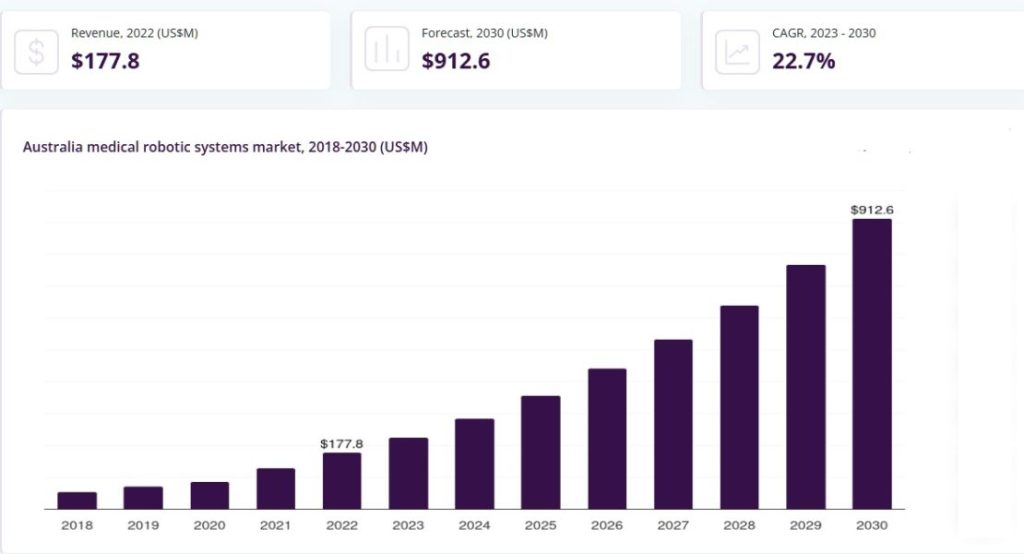Since the first medical robots came onto the Australian market , there has been an increase in the number of hospitals and medical practices installing robots into their operating rooms.
There are many pros and cons to this practice including how it can help the healthcare system, the effect on the labor force and patient satisfaction, as well as the impact on the budget for the Australian Government.
Although there are currently only a small handful of medical robots in Australia, this does not mean that the country is unable or unwilling to continue expanding the use of robots in their operating theatres.
As time passes, technology advances and medical advancements are made, robots become more capable and more affordable. This means that they can perform more duties than before and can help surgeons carry out increasingly difficult tasks.
Robotic devices have become one of the preferred tools for hospitals because they are able to meet the demands of the healtchare industry.
With the help of expert teams, engineers have been able to design robots that help doctors in specific aspects of surgery become more efficient and effective.
The Da Vinci Surgical Robot.
The Da Vinci Surgical Robot is an innovative robotic surgical machine developed by the American pharmaceutical company Intuitive Surgical.
Approved by the Food and Drug Administration (FDA) in 2000, it is controlled via a computer and designed to facilitate minimally invasive surgery using an ultrasonic beam.
The robot is intended to be used in operations ranging from joint replacement to heart surgery to hip surgery, and is capable of operating in a number of different situations.
Reducing the need for additional healthcare staff
Even though doctors require help sometimes, it does not mean that complicated operations cannot be performed. This is a reason why robotic devices for the healtchare industry was introduced to the country.
These robotic systems and devices help with surgeries inside the hospital without the help of any additional human doctors. This also makes it easier for patients who feel uncomfortable having someone other than a doctor present during their surgical procedure.
Robotics Engineers
Robotic engineers are also one of the team members who help the hospitals with its overall healthcare. These engineers are responsible for the designs and the maintenance of these complicated robotic devices.
They are also responsible for troubleshooting and repairing the existing systems if there is a need to replace any of them.
Since the entire team is made up of robotic engineers, there is less chance that they will get into trouble when they are troubleshooting or repairing any of the robotic devices.
Medical Robots in Australia: Market Impact and Advances (2023-2024)

Medical robots are making waves in the Australian healthcare industry, significantly enhancing how patients are treated and how care is delivered.
These high-tech innovations are proving to be game-changers, especially in areas like surgery, rehabilitation, and diagnostics. Between 2023 and 2024, their impact has been undeniable, driven by growing investments and a commitment to improving patient outcomes.
The Growth of Medical Robots in Australia
In the past year, medical robots have gained traction in hospitals and clinics across Australia. Government funding and private investments have been key drivers, as healthcare providers look to modernise their systems.
These robots are particularly popular in surgical applications, where they boost precision and reduce recovery times.
Rehabilitation centers are also adopting robotic aids to help patients regain mobility, while diagnostic robots are making early disease detection more accurate than ever.
Key Facts and Figures
- Market Growth:
- Australia’s medical robotics market has been growing at an impressive rate of 8.5% annually. By late 2024, it’s expected to be worth around AUD 500 million.
- Surgical robots dominate the sector, accounting for about two-thirds of the market, followed by robots used in rehabilitation and hospital operations.
- Australia’s medical robotics market has been growing at an impressive rate of 8.5% annually. By late 2024, it’s expected to be worth around AUD 500 million.
- Efficiency Gains:
- Robotic-assisted surgeries have reduced patient hospital stays by nearly a third. This is thanks to fewer complications and faster recovery times.
- Diagnostic robots, using advanced AI, have achieved an accuracy rate of over 92% for early disease detection.
- Robotic-assisted surgeries have reduced patient hospital stays by nearly a third. This is thanks to fewer complications and faster recovery times.
- Job Creation:
- The rise of robotics has created thousands of specialised jobs in Australia, including roles in engineering, programming, and clinical training.
- Hospitals are reporting a 15% boost in their ability to handle more surgeries and medical procedures due to these technologies.
- The rise of robotics has created thousands of specialised jobs in Australia, including roles in engineering, programming, and clinical training.
- Better Patient Outcomes:
- Recovery times for patients undergoing robotic-assisted surgeries have dropped by 40% compared to traditional methods.
- Rehabilitation robots have shown remarkable success, improving movement and quality of life for over 85% of patients treated with these devices.
- Recovery times for patients undergoing robotic-assisted surgeries have dropped by 40% compared to traditional methods.
Breakthrough Applications
- Robotic Surgeries:
- Robots like the da Vinci system are being used in Australian hospitals for procedures such as heart surgery and gastric bypass. These systems allow for incredible precision, minimizing the risks involved in complex surgeries.
- Research from 2023 shows robotic surgeries not only improve recovery times but are also cost-effective in the long run.
- Robots like the da Vinci system are being used in Australian hospitals for procedures such as heart surgery and gastric bypass. These systems allow for incredible precision, minimizing the risks involved in complex surgeries.
- Rehabilitation Robots:
- Wearable robotics and exoskeletons are helping patients with spinal injuries and strokes regain independence. These devices provide crucial physical support during recovery.
- Wearable robotics and exoskeletons are helping patients with spinal injuries and strokes regain independence. These devices provide crucial physical support during recovery.
- Diagnostics in Remote Areas:
- Robots equipped with diagnostic AI are being deployed in rural and underserved regions, providing access to healthcare that was previously out of reach.
- Robots equipped with diagnostic AI are being deployed in rural and underserved regions, providing access to healthcare that was previously out of reach.
- Supporting Hospital Staff:
- Robots that handle tasks like disinfecting rooms and delivering supplies are reducing the workload for healthcare staff, allowing them to focus more on patient care.
- Robots that handle tasks like disinfecting rooms and delivering supplies are reducing the workload for healthcare staff, allowing them to focus more on patient care.
Australian Medical Robotic Systems Market Size & Outlook

The medical robotics sector in Australia is poised for substantial growth, driven by technological advancements and a surge in healthcare demand.
By 2030, the market is projected to generate an impressive revenue of US$912.6 million, reflecting its expanding role in modern healthcare systems.
Market Expansion and Growth Rate
From 2023 to 2030, Australia’s medical robotic systems market is forecasted to grow at a compound annual growth rate (CAGR) of 22.7%. The remarkable growth highlights the sector’s increasing adoption across hospitals and healthcare facilities.
Key Factors Driving Growth
- Technological Innovation: The integration of AI with robotics enhances precision and efficiency, making these systems indispensable in surgeries and patient care.
- Healthcare Demand: An aging population and a focus on improving healthcare outcomes have led to increased investments in robotic technologies.
- Government Support: Policies encouraging research and development in medical robotics play a vital role in accelerating market growth.
Future Outlook
As the market approaches 2030, the advancements in medical robotics are expected to redefine patient care standards in Australia. This includes further developments in minimally invasive surgeries, rehabilitation aids, and telemedicine solutions powered by robotics.
Medical robots are not only transforming how healthcare is delivered but also positioning Australia as a leader in medical technology innovation. With robust growth expected, the next decade marks a pivotal period for the sector.
Challenges and What’s Next
Despite their benefits, medical robots come with challenges. High upfront costs and ongoing maintenance expenses can be barriers, especially for smaller hospitals.
There’s also a need for specialised training to operate and maintain these machines. However, Australia is addressing these challenges by increasing funding for research and development. The future looks promising, with plans to expand the use of robots into elder care and telemedicine.
Summary Of Medical Robotic Systems Market Data Book
| Market revenue in 2022 | USD 177.8 million |
| Market revenue in 2030 | USD 912.6 million |
| Growth rate | 22.7% (CAGR from 2022 to 2030) |
| Largest segment | Medical service robots |
| Fastest growing segment | Cleanroom Robots |
| Historical data | 2018 – 2021 |
| Base year | 2022 |
| Forecast period | 2023 – 2030 |
| Quantitative units | Revenue in USD million |
| Market segmentation | Surgical Robots (By Application), Exo-Robots (By Extremities), Pharma Robots, Cleanroom Robots, Robotic Prosthetics, Medical Service Robots |
| Key market players worldwide | IRobot Corp, Medrobotics, Titan Medical Inc, Renishaw PLC, Health Robotics S.R.L, Intuitive Surgical Inc, Stryker Corp, Stereotaxis Inc, Medtronic PLC, Zimmer Biomet Holdings Inc, Smith & Nephew PLC |
The Australian medical robotic systems market is experiencing rapid growth, offering significant opportunities for companies, investors, and researchers.
Designed as a comprehensive resource, the Horizon Databook provides detailed insights into market statistics, year-on-year growth, and compound annual growth rate (CAGR), enabling stakeholders to understand the sector’s dynamics effectively.
Market Landscape and Key Segments
Medical service robots led the market in 2022, commanding a 62.54% revenue share, reflecting their widespread adoption in healthcare facilities. The Horizon Databook segments the market into various categories, providing detailed revenue insights for each sub-segment from 2018 to 2030:
- Surgical Robots (analysed by application)
- Exoskeleton Robots (segmented by extremity)
- Pharmaceutical Robots
- Cleanroom Robots
- Robotic Prosthetics
- Medical Service Robots
Medical Robots Revolutionising Global Healthcare in 2024
Medical robots are transforming the healthcare landscape worldwide, introducing revolutionary solutions to enhance patient care and address critical challenges.
In 2024, the global adoption of medical robotics has reached new heights, impacting surgical precision, diagnostics, rehabilitation, and even day-to-day hospital operations.
The integration of robots in healthcare is addressing long-standing issues such as labor shortages, patient safety, and the demand for minimally invasive procedures.
Additionally, autonomous robots are being deployed in hospitals to disinfect spaces, deliver supplies, and assist in patient mobility, streamlining operations and reducing staff workloads.
Rehabilitation robots, especially in developed markets, are helping patients regain movement and independence more effectively than traditional methods.
Key Developments in 2024
- Surgical Advances: The use of robotic-assisted surgical systems is no longer confined to high-end facilities. Emerging markets are adopting this technology, boosting access to life-saving procedures for millions of patients.
- AI-Driven Diagnostics: Robots equipped with artificial intelligence are being utilized to detect diseases earlier and with greater accuracy, revolutionizing fields like oncology and cardiology.
- Global Labor Solutions: Countries facing healthcare labor shortages, such as Japan and parts of Europe, are increasingly deploying robots to fill gaps in caregiving and routine hospital tasks.
- Telemedicine Integration: Robots are playing a pivotal role in telemedicine, enabling remote consultations and even remote-controlled surgeries, bridging the gap between patients and specialists in underserved areas.
Report Conclusion
Medical robots are shaping the future of healthcare in Australia. They’re improving surgical precision, cutting recovery times, and filling gaps in the healthcare workforce.
As technology continues to evolve, these machines are set to play an even larger role in making healthcare more efficient and accessible for everyone.







